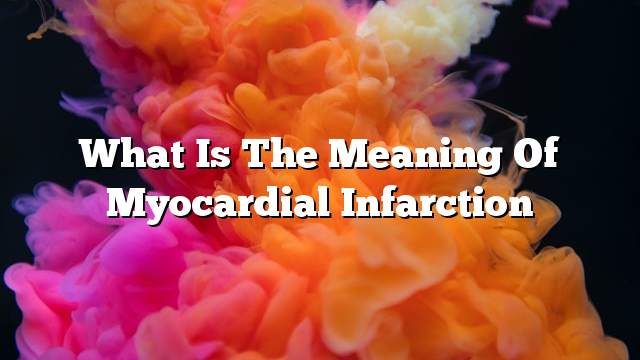Definition of myocardial infarction
Myocardial infarction is the scientific name of a heart attack, a condition that is common and dangerous to human life, and according to many of the leading studies of the cause of death in the world. The heart muscle receives blood and food through three main arteries known as coronary arteries, often with a sudden blockage of one or more of these arteries or branches due to several causes, most notably a thrombosis composed of Fat and some cellular waste in these arteries, called the condition of atherosclerosis, and thus enter the damaged heart tissue in a condition called lack of perfusion, which occurs when cutting oxygen from the cells, if this continues for a longer time, die cells and the patient myocardial infarction.
Although most cases result from coronary atherosclerosis, some of them result from the temporary contraction of these arteries, and the inflammation has been found to play a role in the development of heart attack, it facilitates the accumulation of fatty clots in the inflamed arteries. Angina is an early warning of a heart attack, which occurs before many heart attacks, and may occur in the form of bouts of chest pain due to lack of perfusion. However, this pain lasts for less time than that associated with myocardial infarction, Without causing permanent damage to the heart tissue.
Symptoms associated with myocardial infarction
Most cases of myocardial infarction occur early in the morning or after physical exertion. Symptoms vary from patient to patient, and some may come without causing any symptoms, such as what often happens to diabetics. The symptoms associated with myocardial infarction are as follows:
- Feeling of pressure or age or heavy in the middle part of the chest. The pain may be felt in the jaws, teeth, shoulder, arm, or back.
- Suffering from breathlessness.
- Feeling nausea, abdominal pain, burning or vomiting.
- Suffering from excessive sweating.
- Loss of consciousness or lack of cognitive level.
Factors that increase the risk of myocardial infarction
Some factors increase the risk of myocardial infarction by contributing to the formation of sebaceous clots. It is therefore necessary to avoid the avoidance of these factors. Meeting some of these factors at the same time increases the chances of infection. The risk factors are as follows:
- Age: The chance of getting older increases, and men older than 45 years and women older than 55 years are more likely to develop myocardial infarction.
- Suffering from Hypertension: Normal blood pressure is less than 120/80 mm Hg. Hypertension causes damage to blood vessels and contributes to atherosclerosis.
- Obesity: It is considered a risk factor; it is usually associated with high blood pressure, diabetes and high fat as well.
- Smoking.
- Suffering from Diabetes: High blood sugar contributes to coronary artery dysfunction.
- High levels of cholesterol and triglycerides in the blood: The high level of LDL cholesterol, or so-called low-density lipoprotein (LDL), at the expense of high-density, high-density lipoprotein, and high triglyceride levels, contribute significantly to atherosclerosis and myocardial infarction.
- The risk of myocardial infarction increases when there is a family history of this condition at an early age.
- There are also other factors such as lack of physical activity, stress, substance abuse, and autoimmune diseases, in which the immune system attacks various body organs such as rheumatoid arthritis.
Treatment of myocardial infarction
Diagnosis of myocardial infarction begins with a clinical examination, measuring vital signs of the patient, such as blood pressure, heart rate, breathing speed, electrocardiography, and blood tests to detect heart enzymes associated with heart attack such as troposon.
As an emergency, some remedial procedures must be followed immediately to restore the heart’s perfusion and to prevent further damage to the tissues. These include oxygen, painkillers such as morphine, and the use of nitroglycerin, which expands the coronary arteries and their branches, Which achieve many benefits, such as reducing heart rate, blood pressure, thus reducing the effort exerted by the heart muscle. It is also necessary to use drugs that prevent the formation of clotting and analysis, most notably aspirin, which reduces the rate of clotting, and thus maintain the passage of blood through the blood vessels affected, and can also the use of anti-platelets and anticoagulant drugs, and medicines inhibitory Glycoprotein 2b 3a, Drugs for thrombosis.
After these emergency procedures, doctors perform cardiac catheterization as soon as possible, to locate the blockage, and then insert a tube through a major artery to the heart to work to open the blockage, by placing a balloon or mesh to keep the arteries open. If the heart catheterization is not effective, or if there are many coronary blockages, doctors will have surgery to open a bypass in the coronary artery, allowing the passage to pass through the blood stream while avoiding the blockage.
